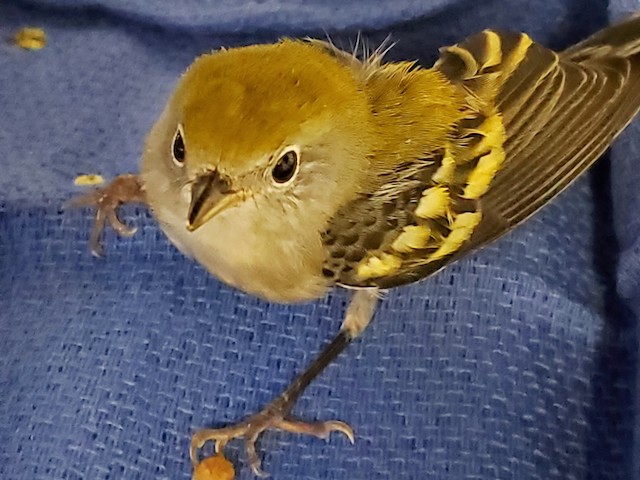By Rebecca Michelin, Director of Wildlife Rehabilitation
 You may have heard the devastating news- a study published this month in the journal Science reports that the total breeding bird population in the continental U.S. and Canada has dropped by 29 percent since 1970.
You may have heard the devastating news- a study published this month in the journal Science reports that the total breeding bird population in the continental U.S. and Canada has dropped by 29 percent since 1970.
While there are numerous factors contributing to this decline, human-made alterations to the landscape have certainly played a significant role, and we see the results of this clearly at the Wildlife Clinic at the Schuylkill Center. Since mid-August, the wildlife clinic has treated nearly two dozen birds, from mourning doves and woodpeckers to warblers and vireos, all suffering injuries as a result of collisions with buildings and windows.
The number of window collisions increases drastically in late summer and early fall as many migratory birds make their way down the East coast from their summer breeding grounds.
Exhausted from long miles of travel, birds looking for a safe place to roost can become confused and disoriented by brightly lit buildings, complex city skylines, and clear glass windows. Fledgling and juvenile birds who are just learning to fly are also susceptible to striking windows as they have no prior experience with the many dangers they face.
Glass is just as invisible to humans as it is to birds, but humans have learned to recognize visual cues indicating the presence of glass such as certain shapes, frames, and even dirt or smudges. This is why young children can often be seen bumping into pane glass doors they haven’t yet recognized those cues. These symbols aren’t helpful to birds, however, who don’t recognize glass as a barrier – for many birds, their first encounter with glass is often fatal as they collide head first at full flight speed. If the impact is not immediately deadly, birds will often suffer severe head and spinal trauma or fractures of the neck and shoulders, injuries which they may not be able to recover from, even with treatment.
To help limit bird collisions with windows at your home or business, there are a variety of options available:
• Panels of fine mesh or screen placed over the window helps increase visibility and acts as a cushion to prevent birds hitting the glass.
• Creating patterns on the outside of glass ensures they are visible even with highly reflective windows. Reflective tape or glass paint markers can be used to create horizontal lines no more than 2” apart, or vertical lines a maximum of 4” apart
• UV films and decals can be applied to windows or reflective surfaces which are nearly invisible to humans but are clearly seen by birds
If you see an adult bird sitting on the ground or sidewalk and they do not move when approached, they may have struck a window and be stunned or injured. If the bird appears to be having trouble breathing (gasping, visible chest movement), has a wing or leg held out from the body, is squinting their eyes, or has other visible signs of injury, that bird should be brought to a rehabilitation facility immediately. You can use a small towel or t-shirt to drop over the bird and gently place them in a cardboard box or other secure container. Do not offer food or water, just keep the bird warm, covered, and away from loud noises or other stressors until they can be brought to the nearest rehabber.
Many times, injuries from a window collision may not be immediately visible. In some cases, the bird may appear fine and even be able to flutter a short distance. If in doubt, call the wildlife clinic hotline (215-482-7300 x option 2) or contain the bird as instructed above and bring them to the clinic. Rehabilitators are trained to look for signs of injury that may not be obvious, and we can help ensure that the birds are fully recovered before continuing on their migration journey.
